Page 1032 of 4366
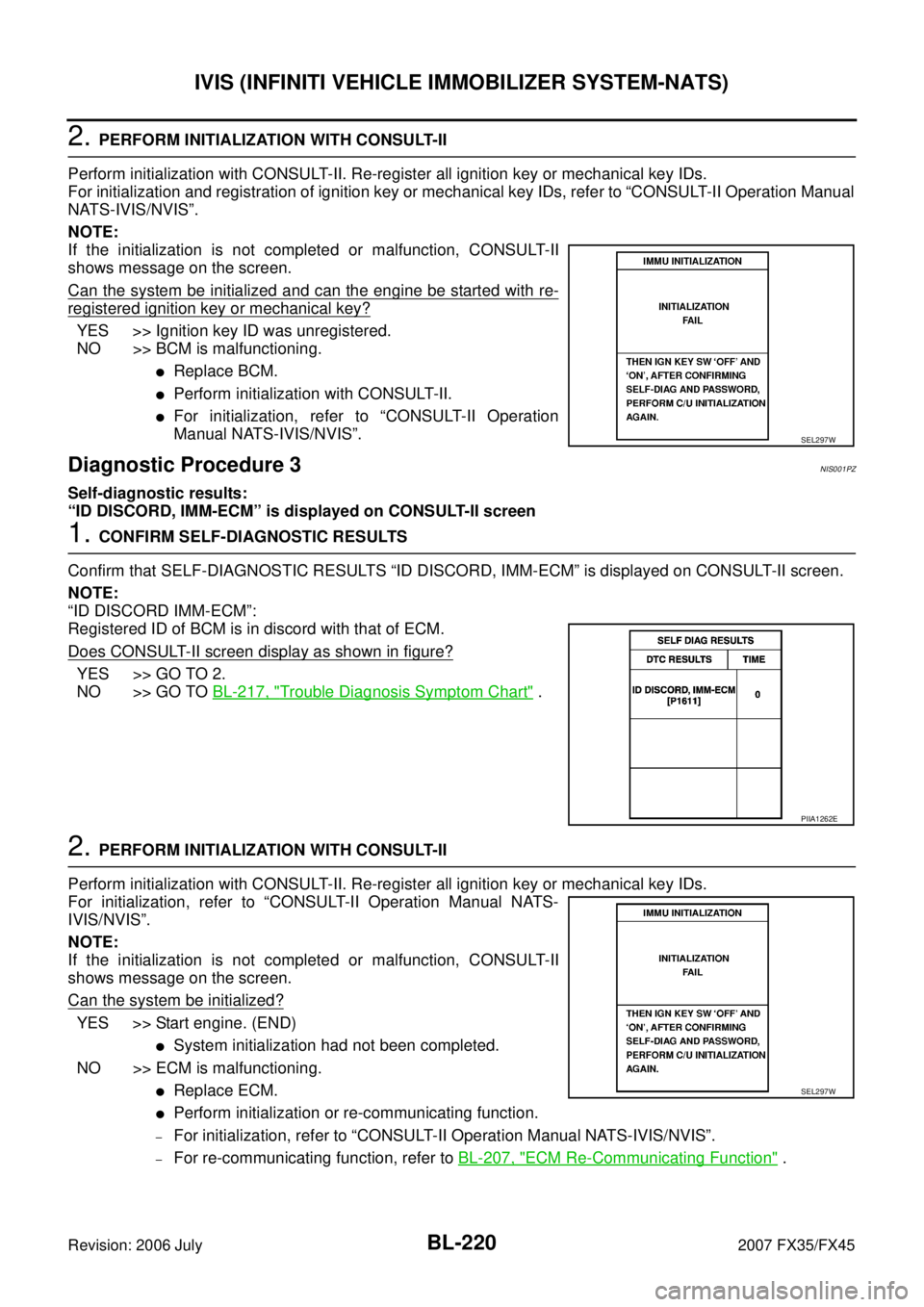
BL-220
IVIS (INFINITI VEHICLE IMMOBILIZER SYSTEM-NATS)
Revision: 2006 July 2007 FX35/FX45
2. PERFORM INITIALIZATION WITH CONSULT-II
Perform initialization with CONSULT-II. Re-register all ignition key or mechanical key IDs.
For initialization and registration of ignition key or mechanical key IDs, refer to “CONSULT-II Operation Manual
NATS-IVIS/NVIS”.
NOTE:
If the initialization is not completed or malfunction, CONSULT-II
shows message on the screen.
Can the system be initialized and can the engine be started with re-
registered ignition key or mechanical key?
YES >> Ignition key ID was unregistered.
NO >> BCM is malfunctioning.
�Replace BCM.
�Perform initialization with CONSULT-II.
�For initialization, refer to “CONSULT-II Operation
Manual NATS-IVIS/NVIS”.
Diagnostic Procedure 3NIS001PZ
Self-diagnostic results:
“ID DISCORD, IMM-ECM” is displayed on CONSULT-II screen
1. CONFIRM SELF-DIAGNOSTIC RESULTS
Confirm that SELF-DIAGNOSTIC RESULTS “ID DISCORD, IMM-ECM” is displayed on CONSULT-II screen.
NOTE:
“ID DISCORD IMM-ECM”:
Registered ID of BCM is in discord with that of ECM.
Does CONSULT-II screen display as shown in figure?
YES >> GO TO 2.
NO >> GO TO BL-217, "
Trouble Diagnosis Symptom Chart" .
2. PERFORM INITIALIZATION WITH CONSULT-II
Perform initialization with CONSULT-II. Re-register all ignition key or mechanical key IDs.
For initialization, refer to “CONSULT-II Operation Manual NATS-
IVIS/NVIS”.
NOTE:
If the initialization is not completed or malfunction, CONSULT-II
shows message on the screen.
Can the system be initialized?
YES >> Start engine. (END)
�System initialization had not been completed.
NO >> ECM is malfunctioning.
�Replace ECM.
�Perform initialization or re-communicating function.
–For initialization, refer to “CONSULT-II Operation Manual NATS-IVIS/NVIS”.
–For re-communicating function, refer to BL-207, "ECM Re-Communicating Function" .
SEL297W
PIIA1262E
SEL297W
Page 1033 of 4366
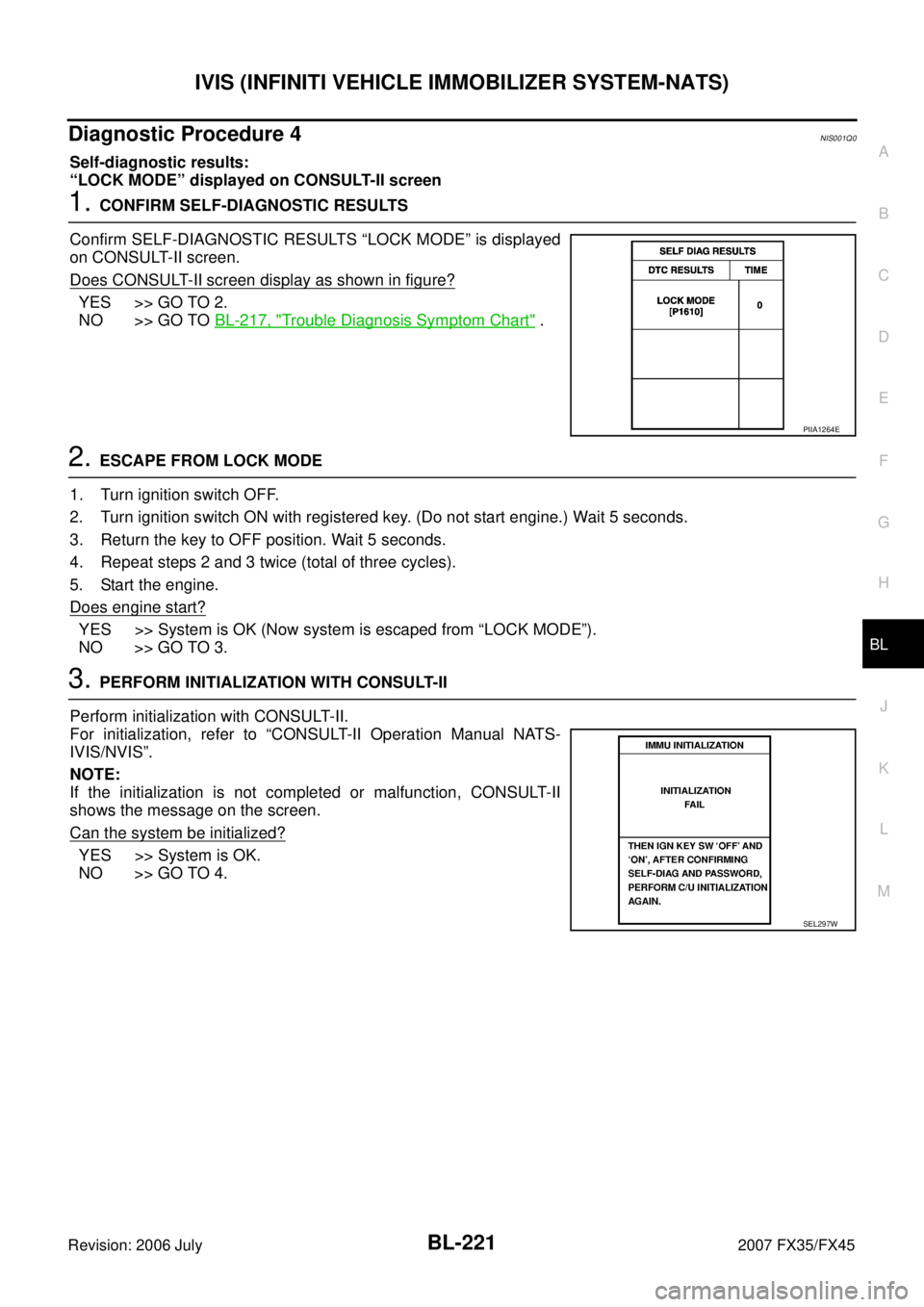
IVIS (INFINITI VEHICLE IMMOBILIZER SYSTEM-NATS) BL-221
C
D E
F
G H
J
K L
M A
B
BL
Revision: 2006 July 2007 FX35/FX45
Diagnostic Procedure 4NIS001Q0
Self-diagnostic results:
“LOCK MODE” displayed on CONSULT-II screen
1. CONFIRM SELF-DIAGNOSTIC RESULTS
Confirm SELF-DIAGNOSTIC RESULTS “LOCK MODE” is displayed
on CONSULT-II screen.
Does CONSULT-II screen display as shown in figure?
YES >> GO TO 2.
NO >> GO TO BL-217, "
Trouble Diagnosis Symptom Chart" .
2. ESCAPE FROM LOCK MODE
1. Turn ignition switch OFF.
2. Turn ignition switch ON with registered key. (Do not start engine.) Wait 5 seconds.
3. Return the key to OFF position. Wait 5 seconds.
4. Repeat steps 2 and 3 twice (total of three cycles).
5. Start the engine.
Does engine start?
YES >> System is OK (Now system is escaped from “LOCK MODE”).
NO >> GO TO 3.
3. PERFORM INITIALIZATION WITH CONSULT-II
Perform initialization with CONSULT-II.
For initialization, refer to “CONSULT-II Operation Manual NATS-
IVIS/NVIS”.
NOTE:
If the initialization is not completed or malfunction, CONSULT-II
shows the message on the screen.
Can the system be initialized?
YES >> System is OK.
NO >> GO TO 4.
PIIA1264E
SEL297W
Page 1034 of 4366
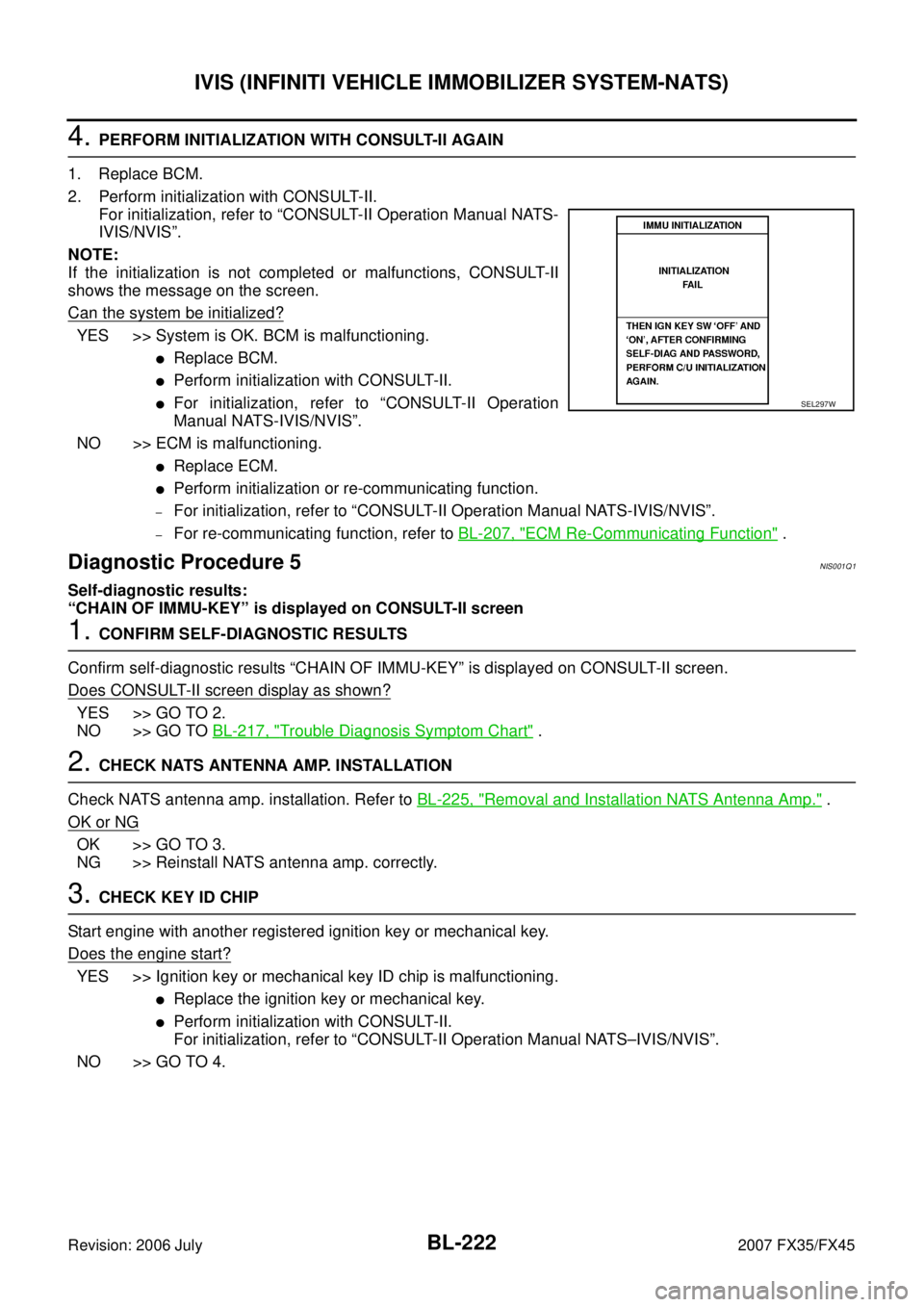
BL-222
IVIS (INFINITI VEHICLE IMMOBILIZER SYSTEM-NATS)
Revision: 2006 July 2007 FX35/FX45
4. PERFORM INITIALIZATION WITH CONSULT-II AGAIN
1. Replace BCM.
2. Perform initialization with CONSULT-II. For initialization, refer to “CONSULT-II Operation Manual NATS-
IVIS/NVIS”.
NOTE:
If the initialization is not completed or malfunctions, CONSULT-II
shows the message on the screen.
Can the system be initialized?
YES >> System is OK. BCM is malfunctioning.
�Replace BCM.
�Perform initialization with CONSULT-II.
�For initialization, refer to “CONSULT-II Operation
Manual NATS-IVIS/NVIS”.
NO >> ECM is malfunctioning.
�Replace ECM.
�Perform initialization or re-communicating function.
–For initialization, refer to “CONSULT-II Operation Manual NATS-IVIS/NVIS”.
–For re-communicating function, refer to BL-207, "ECM Re-Communicating Function" .
Diagnostic Procedure 5NIS001Q1
Self-diagnostic results:
“CHAIN OF IMMU-KEY” is displayed on CONSULT-II screen
1. CONFIRM SELF-DIAGNOSTIC RESULTS
Confirm self-diagnostic results “CHAIN OF IMMU-KEY” is displayed on CONSULT-II screen.
Does CONSULT-II screen display as shown?
YES >> GO TO 2.
NO >> GO TO BL-217, "
Trouble Diagnosis Symptom Chart" .
2. CHECK NATS ANTENNA AMP. INSTALLATION
Check NATS antenna amp. installation. Refer to BL-225, "
Removal and Installation NATS Antenna Amp." .
OK or NG
OK >> GO TO 3.
NG >> Reinstall NATS antenna amp. correctly.
3. CHECK KEY ID CHIP
Start engine with another registered ignition key or mechanical key.
Does the engine start?
YES >> Ignition key or mechanical key ID chip is malfunctioning.
�Replace the ignition key or mechanical key.
�Perform initialization with CONSULT-II.
For initialization, refer to “CONSULT-II Operation Manual NATS–IVIS/NVIS”.
NO >> GO TO 4.
SEL297W
Page 1036 of 4366
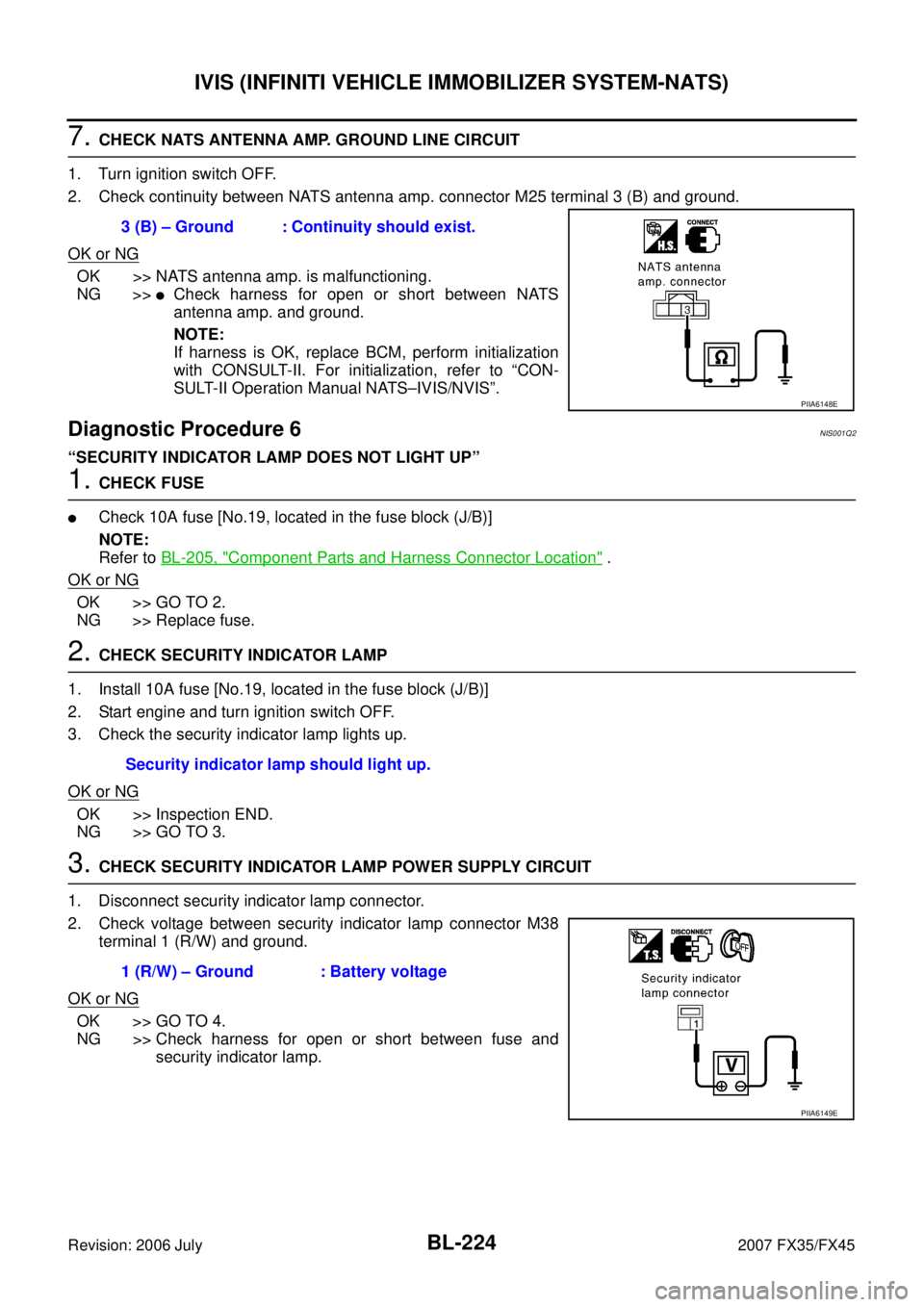
BL-224
IVIS (INFINITI VEHICLE IMMOBILIZER SYSTEM-NATS)
Revision: 2006 July 2007 FX35/FX45
7. CHECK NATS ANTENNA AMP. GROUND LINE CIRCUIT
1. Turn ignition switch OFF.
2. Check continuity between NATS antenna amp. connector M25 terminal 3 (B) and ground.
OK or NG
OK >> NATS antenna amp. is malfunctioning.
NG >>
�Check harness for open or short between NATS
antenna amp. and ground.
NOTE:
If harness is OK, replace BCM, perform initialization
with CONSULT-II. For initialization, refer to “CON-
SULT-II Operation Manual NATS–IVIS/NVIS”.
Diagnostic Procedure 6NIS001Q2
“SECURITY INDICATOR LAMP DOES NOT LIGHT UP”
1. CHECK FUSE
�Check 10A fuse [No.19, located in the fuse block (J/B)]
NOTE:
Refer to BL-205, "
Component Parts and Harness Connector Location" .
OK or NG
OK >> GO TO 2.
NG >> Replace fuse.
2. CHECK SECURITY INDICATOR LAMP
1. Install 10A fuse [No.19, located in the fuse block (J/B)]
2. Start engine and turn ignition switch OFF.
3. Check the security indicator lamp lights up.
OK or NG
OK >> Inspection END.
NG >> GO TO 3.
3. CHECK SECURITY INDICATOR LAMP POWER SUPPLY CIRCUIT
1. Disconnect security indicator lamp connector.
2. Check voltage between security indicator lamp connector M38 terminal 1 (R/W) and ground.
OK or NG
OK >> GO TO 4.
NG >> Check harness for open or short between fuse and security indicator lamp.
3 (B) – Ground : Continuity should exist.
PIIA6148E
Security indicator lamp should light up.
1 (R/W) – Ground : Battery voltage
PIIA6149E
Page 1057 of 4366
BODY REPAIR BL-245
C
D E
F
G H
J
K L
M A
B
BL
Revision: 2006 July 2007 FX35/FX45
ENGINE COMPARTMENT
Measurement
SIIA2260E
Page 1100 of 4366
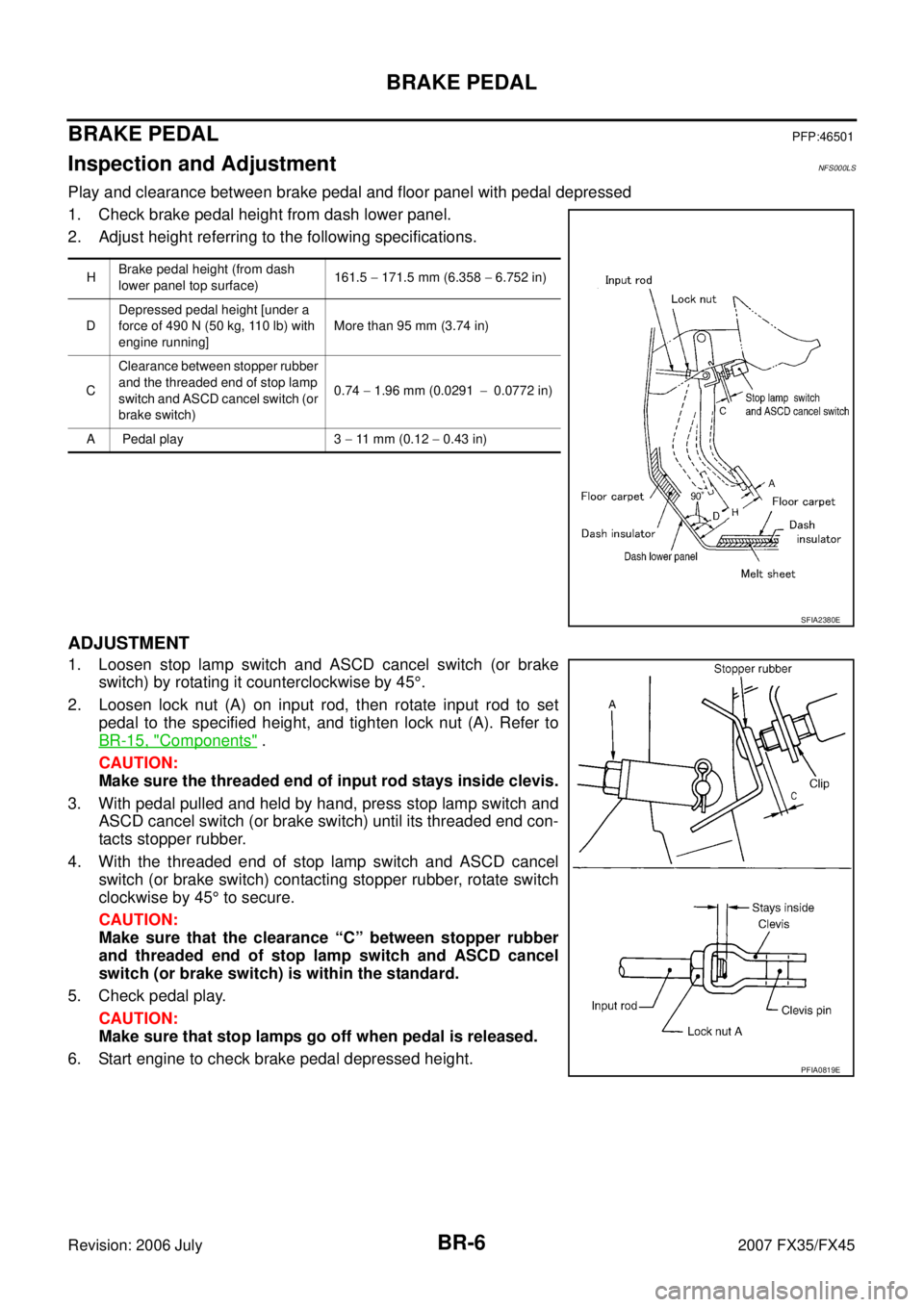
BR-6
BRAKE PEDAL
Revision: 2006 July 2007 FX35/FX45
BRAKE PEDALPFP:46501
Inspection and AdjustmentNFS000LS
Play and clearance between brake pedal and floor panel with pedal depressed
1. Check brake pedal height from dash lower panel.
2. Adjust height referring to the following specifications.
ADJUSTMENT
1. Loosen stop lamp switch and ASCD cancel switch (or brake switch) by rotating it counterclockwise by 45 °.
2. Loosen lock nut (A) on input rod, then rotate input rod to set pedal to the specified height, and tighten lock nut (A). Refer to
BR-15, "
Components" .
CAUTION:
Make sure the threaded end of input rod stays inside clevis.
3. With pedal pulled and held by hand, press stop lamp switch and ASCD cancel switch (or brake switch) until its threaded end con-
tacts stopper rubber.
4. With the threaded end of stop lamp switch and ASCD cancel switch (or brake switch) contacting stopper rubber, rotate switch
clockwise by 45 ° to secure.
CAUTION:
Make sure that the clearance “C” between stopper rubber
and threaded end of stop lamp switch and ASCD cancel
switch (or brake switch) is within the standard.
5. Check pedal play. CAUTION:
Make sure that stop lamps go off when pedal is released.
6. Start engine to check brake pedal depressed height.
H Brake pedal height (from dash
lower panel top surface) 161.5
− 171.5 mm (6.358 − 6.752 in)
D Depressed pedal height [under a
force of 490 N (50 kg, 110 lb) with
engine running] More than 95 mm (3.74 in)
C Clearance between stopper rubber
and the threaded end of stop lamp
switch and ASCD cancel switch (or
brake switch) 0.74
− 1.96 mm (0.0291 −0.0772 in)
A Pedal play 3 − 11 mm (0.12 − 0.43 in)
SFIA2380E
PFIA0819E
Page 1106 of 4366
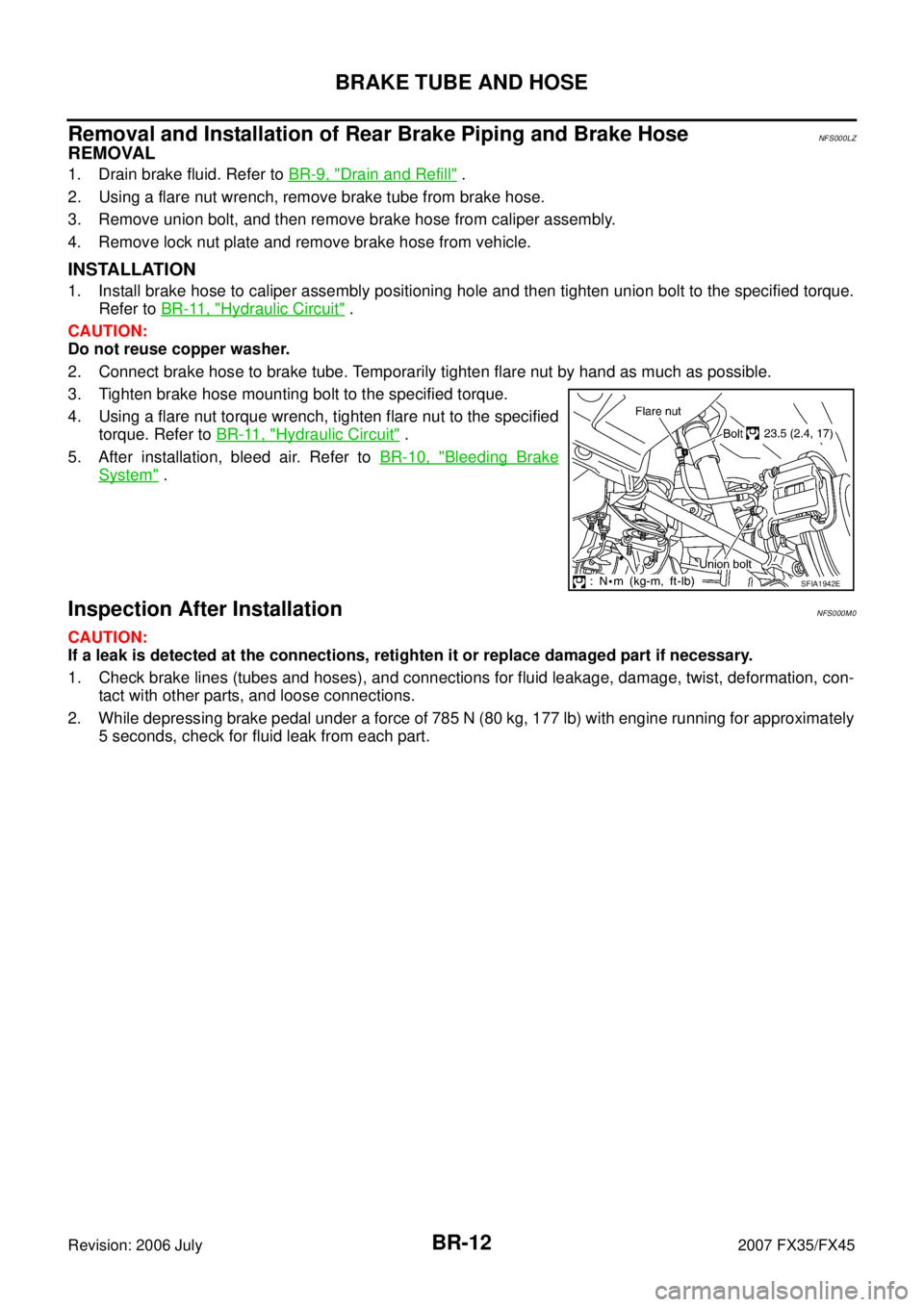
BR-12
BRAKE TUBE AND HOSE
Revision: 2006 July 2007 FX35/FX45
Removal and Installation of Rear Brake Piping and Brake Hose NFS000LZ
REMOVAL
1. Drain brake fluid. Refer to BR-9, "Drain and Refill" .
2. Using a flare nut wrench, remove brake tube from brake hose.
3. Remove union bolt, and then remove brake hose from caliper assembly.
4. Remove lock nut plate and remove brake hose from vehicle.
INSTALLATION
1. Install brake hose to caliper assembly positioning hole and then tighten union bolt to the specified torque. Refer to BR-11, "
Hydraulic Circuit" .
CAUTION:
Do not reuse copper washer.
2. Connect brake hose to brake tube. Temporarily tighten flare nut by hand as much as possible.
3. Tighten brake hose mounting bolt to the specified torque.
4. Using a flare nut torque wrench, tighten flare nut to the specified torque. Refer to BR-11, "
Hydraulic Circuit" .
5. After installation, bleed air. Refer to BR-10, "
Bleeding Brake
System" .
Inspection After InstallationNFS000M0
CAUTION:
If a leak is detected at the connections, retighten it or replace damaged part if necessary.
1. Check brake lines (tubes and hoses), and connections for fluid leakage, damage, twist, deformation, con- tact with other parts, and loose connections.
2. While depressing brake pedal under a force of 785 N (80 kg, 177 lb) with engine running for approximately 5 seconds, check for fluid leak from each part.
SFIA1942E
Page 1109 of 4366
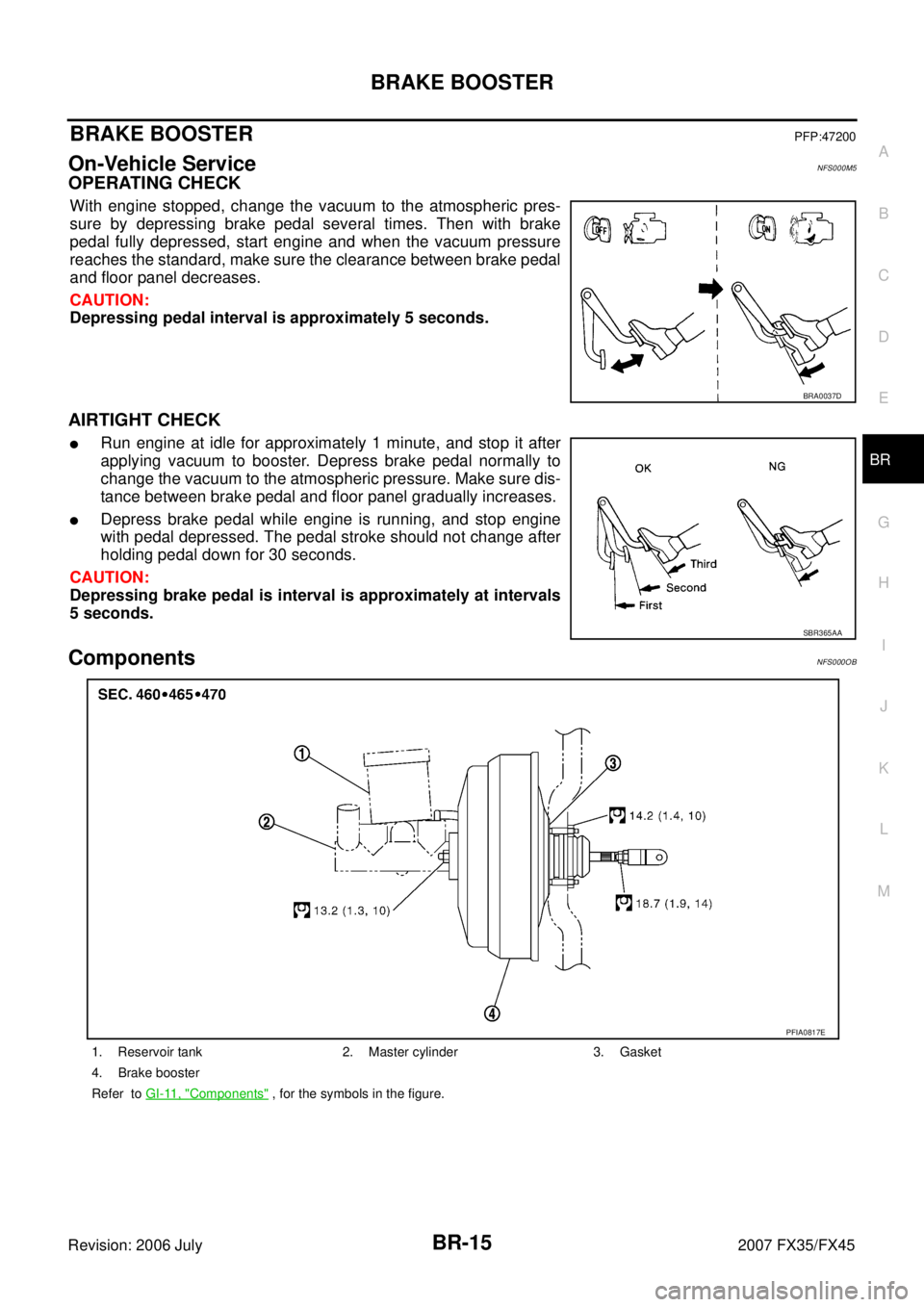
BRAKE BOOSTER BR-15
C
D E
G H
I
J
K L
M A
B
BR
Revision: 2006 July 2007 FX35/FX45
BRAKE BOOSTERPFP:47200
On-Vehicle ServiceNFS000M5
OPERATING CHECK
With engine stopped, change the vacuum to the atmospheric pres-
sure by depressing brake pedal several times. Then with brake
pedal fully depressed, start engine and when the vacuum pressure
reaches the standard, make sure the clearance between brake pedal
and floor panel decreases.
CAUTION:
Depressing pedal interval is approximately 5 seconds.
AIRTIGHT CHECK
�Run engine at idle for approximately 1 minute, and stop it after
applying vacuum to booster. Depress brake pedal normally to
change the vacuum to the atmospheric pressure. Make sure dis-
tance between brake pedal and floor panel gradually increases.
�Depress brake pedal while engine is running, and stop engine
with pedal depressed. The pedal stroke should not change after
holding pedal down for 30 seconds.
CAUTION:
Depressing brake pedal is interval is approximately at intervals
5 seconds.
ComponentsNFS000OB
BRA0037D
SBR365AA
1. Reservoir tank 2. Master cylinder 3. Gasket
4. Brake booster
Refer to GI-11, "
Components" , for the symbols in the figure.
PFIA0817E